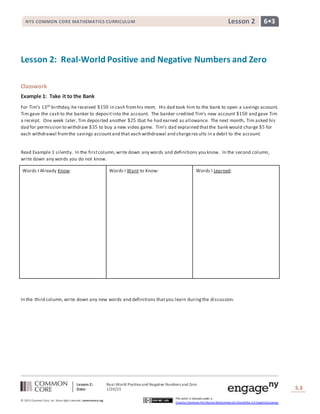
G6 m3-a-lesson 2-s
- 1. Lesson 2: Real-World Positiveand Negative Numbers and Zero Date: 1/20/15 S.3 3 © 2013 Common Core, Inc. Some rightsreserved. commoncore.org This work is licensed under a Creative Commons Attribution-NonCommercial-ShareAlike 3.0 Unported License. NYS COMMON CORE MATHEMATICS CURRICULUM 6•3Lesson 2 Lesson 2: Real-World Positive and Negative Numbers and Zero Classwork Example 1: Take it to the Bank For Tim’s 13th birthday,he received $150 in cash fromhis mom. His dad took him to the bank to open a savings account. Tim gave the cash to the banker to depositinto the account. The banker credited Tim’s new account $150 and gave Tim a receipt. One week later, Tim deposited another $25 that he had earned as allowance. The next month, Tim asked his dad for permission to withdraw $35 to buy a new video game. Tim’s dad explained thatthe bank would charge $5 for each withdrawal fromthe savings accountand that each withdrawal and chargeres ults in a debit to the account. Read Example 1 silently. In the firstcolumn,write down any words and definitions you know. In the second column, write down any words you do not know. Words I Already Know: Words I Want to Know: Words I Learned: In the third column, write down any new words and definitions thatyou learn duringthe discussion.
- 2. Lesson 2: Real-World Positiveand Negative Numbers and Zero Date: 1/20/15 S.4 4 © 2013 Common Core, Inc. Some rightsreserved. commoncore.org This work is licensed under a Creative Commons Attribution-NonCommercial-ShareAlike 3.0 Unported License. NYS COMMON CORE MATHEMATICS CURRICULUM 6•3Lesson 2 Exercises1–2 1. Read Example 1 again. With your partner, number the events in the story problem. Write the number above each sentence to show the order of the events. For Tim’s 13th birthday,he received $150 in cash fromhis mom. His dad took him to the bank to open a savings account. Tim gave the cash to the banker to depositinto the account. The banker credited Tim’s new account $150 and gave Tim a receipt. One week later, Tim deposited another $25 that he had earned as allowance. The next month, Tim asked his dad for permission to withdraw $35 to buy a new video game. Tim’s dad explained thatthe bank would charge $5 for each withdrawal fromthe savings accountand that each withdrawal and chargeresults in a debit to the account. 2. Write each individual description below as an integer. Model the integer on the number lineusingan appropriate scale. EVENT INTEGER NUMBER LINE MODEL Open a bank accountwith $0. Make a $150 deposit. Credit an account for $150. Make a depositof $25. A bank charge of $5. A withdrawal of $35.
- 3. Lesson 2: Real-World Positiveand Negative Numbers and Zero Date: 1/20/15 S.5 5 © 2013 Common Core, Inc. Some rightsreserved. commoncore.org This work is licensed under a Creative Commons Attribution-NonCommercial-ShareAlike 3.0 Unported License. NYS COMMON CORE MATHEMATICS CURRICULUM 6•3Lesson 2 Freezing point of water in ℃ Example 2: How Hot, How Cold? Temperature is commonly measured usingone of two scales,Celsiusor Fahrenheit. In the United States the Fahrenheit system continues to be the accepted standard for non-scientific use. All other countries have adopted Celsius as theprimary scalein use. The thermometer shows how both scales arerelated. a. The boilingpointof water is 100℃. Where is 100 degrees Celsius located on the thermometer to the right? b. On a vertical number line,describethe position of the integer that represents 100℃. c. Write each temperature as an integer. i. The temperature shown to the rightin ℉: ii. The temperature shown to the rightin ℃: iii. Freezing pointof water in Celsius: d. If someone tells you your body temperature is 98.6°, what scalearethey using? How do you know? e. Does the temperature 0 degrees mean the same thing on both scales?
- 4. Lesson 2: Real-World Positiveand Negative Numbers and Zero Date: 1/20/15 S.6 6 © 2013 Common Core, Inc. Some rightsreserved. commoncore.org This work is licensed under a Creative Commons Attribution-NonCommercial-ShareAlike 3.0 Unported License. NYS COMMON CORE MATHEMATICS CURRICULUM 6•3Lesson 2 Exercises3–5 3. Write each word under the appropriatecolumn,“PositiveNumber” or “Negative Number”. Gain Loss Deposit Credit Debit Charge Below Zero Withdraw Owe Receive Positive Number Negative Number 4. Write an integer to represent each of the followingsituations: a. A company loses $345,000 in 2011. b. You earned $25 for dog sitting c. Jacob owes his dad $5. d. The temperature at the sun’s surfaceis about 5,600℃. e. The temperature outside is 4degrees below zero. f. A football player lost 10 yards when he was tackled. 5. Describea situation that can be modeled by the integer −15. Explain whatzero represents in the situation.
- 5. Lesson 2: Real-World Positiveand Negative Numbers and Zero Date: 1/20/15 S.7 7 © 2013 Common Core, Inc. Some rightsreserved. commoncore.org This work is licensed under a Creative Commons Attribution-NonCommercial-ShareAlike 3.0 Unported License. NYS COMMON CORE MATHEMATICS CURRICULUM 6•3Lesson 2 Problem Set 1. Express each situation as an integer in the spaceprovided. a. A gain of 56 points in a game. b. A fee charged of $2.50. c. A temperature of 32 degrees below zero. d. A 56 yard loss. e. The freezing pointof water in Celsius. f. A $12,500 deposit. For questions 2–5, use the thermometer to the right. 2. Each sentence is stated incorrectly. Rewrite the sentence to correctly describeeach situation. a. The temperature is −10 degrees Fahrenheit below zero. b. The temperature is −22 degrees Celsius belowzero. 3. Mark the integer on the thermometer that corresponds to the temperature given. a. 70°F b. 12℃ c. 110℉ d. −4℃ 4. The boilingpointof water is 212°F. Can this thermometer be used to record the temperature of a boilingpotof water? Explain. 5. Kaylon shaded the thermometer to represent a temperature of 20 degrees below zero Celsius as shown in the diagram. Is shecorrect? Why or why not? If necessary,describehow you would fix Kaylon’s shading.